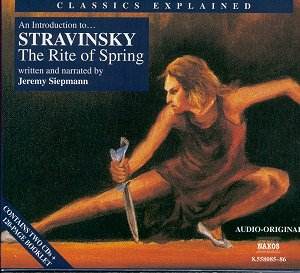This
2-CD set is part of Naxos’s ‘Classics Explained’ series, which
includes other items such as Bach Brandenburg Concertos, the ‘Pastoral’
Symphony, Ravel’s Boléro and so on. The intentions
behind the series are unimpeachable, but the question immediately
arises, do such very well known pieces actually need ‘explaining’?
With a work such as the aforesaid Ravel, the very fact of its
supreme popularity surely suggests that it does not, that the
musical public have understood it very well. I can think of plenty
of music that does need the help of some explanation to the uninitiated
– mainly 20th century works but not all – but, in the
hard realities of the record industry, these works probably wouldn’t
shift enough copies to make it appear a worthwhile effort. What
I really hope is the intention is to maintain the series, and
gradually venture into more uncharted waters. If so, it will surely
develop into an extremely valuable resource.
And
maybe this issue, tackling a hugely popular yet immensely complex
20th century classic, is the herald of just such an
approach. Nobody contests the view that The Rite of
Spring is a key work, perhaps the key work of the early
20th century, and offers a violent introduction to
the harsh new world of modern music. That much can be gleaned
from simply knowing the date of its composition before hearing
a performance (preferably live). But many intelligent music-lovers
will then ask themselves a host of questions. Why did the
composer feel the need to compose such music? Where does
it come from? How exactly did it attack the then existing
language and concept of music? And so on. How far does this issue
go towards answering such questions?
Jeremy
Siepmann certainly makes a brave effort. He is a sensitive, intelligent
musician, and an experienced lecturer, though he does make one
or two odd careless errors. On track 34-35 of CD2, he discusses
a motif he tells us is introduced by the horns, which is
incorrect as it is played by trumpets. In track 35, he
then says ‘And that’s it, as far as this particular motif is concerned.
We never hear from it again.’ How odd, then, that the same motif
crops up in track 36, this time correctly ascribed to the trumpets.
And it appears yet again in track 38, where Siepmann even
manages to play it incorrectly in his piano example! This sort
of confusion can at best cause befuddlement on the listener's
part, and at worst undermine confidence in the speaker.
That
fortunately, though, seems to be the only serious error in Siepmann’s
discussion of the piece. The real problem, however, is a presentational
one, in that, instead of talking intimately or informally, Siepmann
lectures. Not unpleasantly, or even particularly patronisingly.
But he does deliver his text in what I can only describe as a
‘newsreaderly’ manner that makes it sound, oddly, as if he were
reading somebody else’s script, not his own. After a while, this
becomes wearing, and I found my attention wandering during the
many explanations of Stravinsky’s layering of ostinati or his
use of tonal ambiguity.
Occasionally,
things buck up considerably, as when Siepmann describes the ‘Glorification
of the Chosen Victim’, likening his first encounter with this
terrifying music to the news of the Kennedy assassination, or
the 9/11 disasters. Indeed, were the discussion to begin from
that point, i.e. from the intensity of a personal experience,
I believe that most music-lovers would be hooked right away.
Nevertheless,
Siepmann persists right the way through, subjecting many passages
to a rigorous analysis, much of which will, I fear, go way over
the heads of many listeners, though others may well be interested
enough to delve further, and use this exploration as a launch-pad
for their own in-depth investigations. I’m sure that is what Siepmann
and the Naxos team hope will happen, and I too hope that they
are proven to be right.
CD1
concludes with Part 1 of the ballet complete, similarly CD2 with
Part2. What of the performance? It is a worthy rather than a thrilling
one. The recording is clear enough to allow most of Siepmann’s
points to be heard fairly easily (if you are quite sure what you
are supposed to be listening for!). But, in truth, it is a pretty
tame version, and might make one wonder here and there what all
the fuss is about. Then again, nobody can fully comprehend the
Rite until they have heard a fine live performance,
and that’s a point I should like Siepmann to have driven home.
Despite
my reservations, I really wish this project well. Naxos’s launch
of the series is timely, when musicians are becoming belatedly
aware of the need to go out there and present and explain great
music in ways which will attract more listeners to it. I just
wonder if they would be better off letting Jeremy Siepmann prepare
the text, and find somebody else to actually deliver it. Or alternatively
use two presenters, and do the whole thing as a conversation,
which would be much more listener-friendly, and a great aid to
concentration. But I look forward to more issues in this enterprising
and potentially important series.
Gwyn
Parry-Jones
